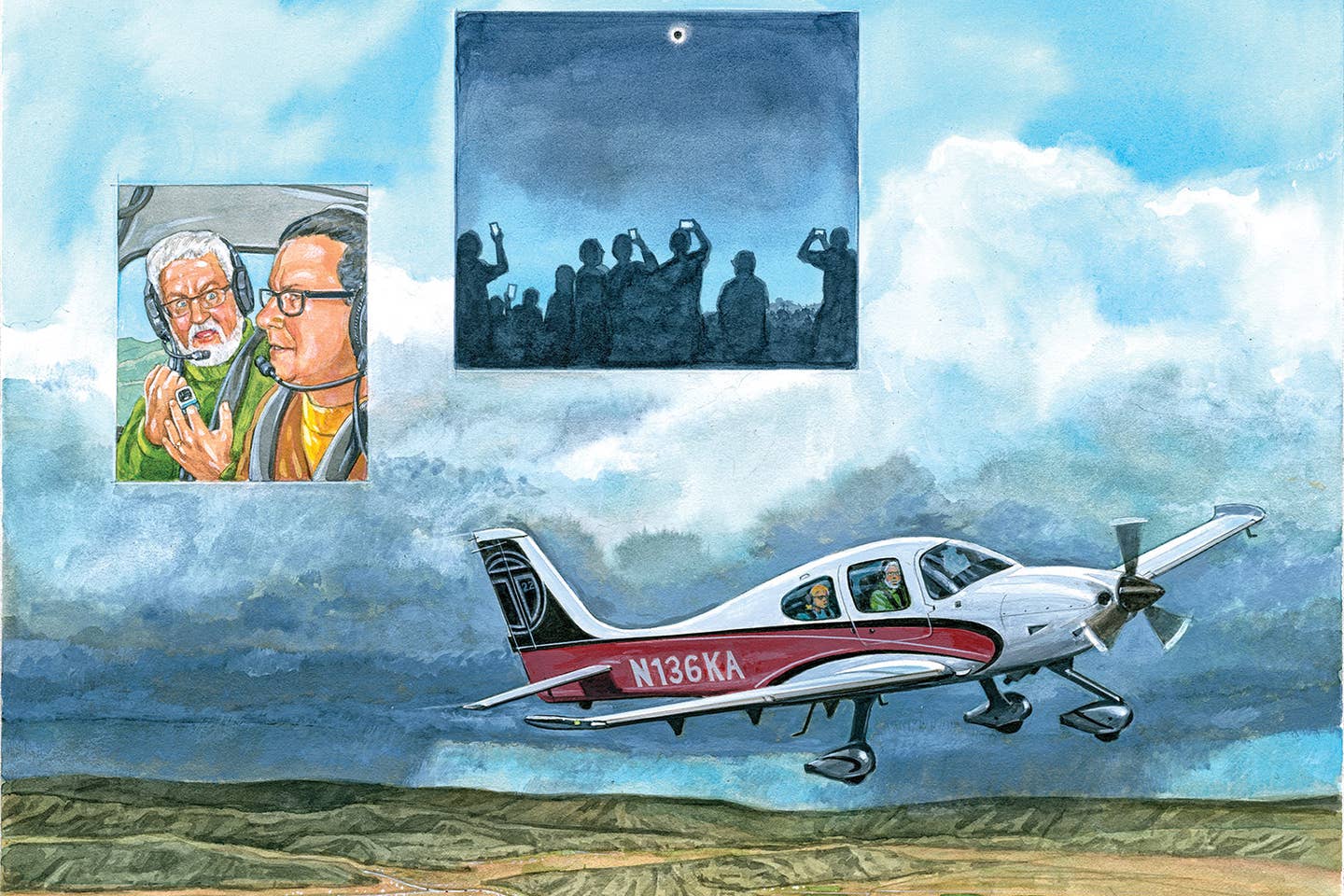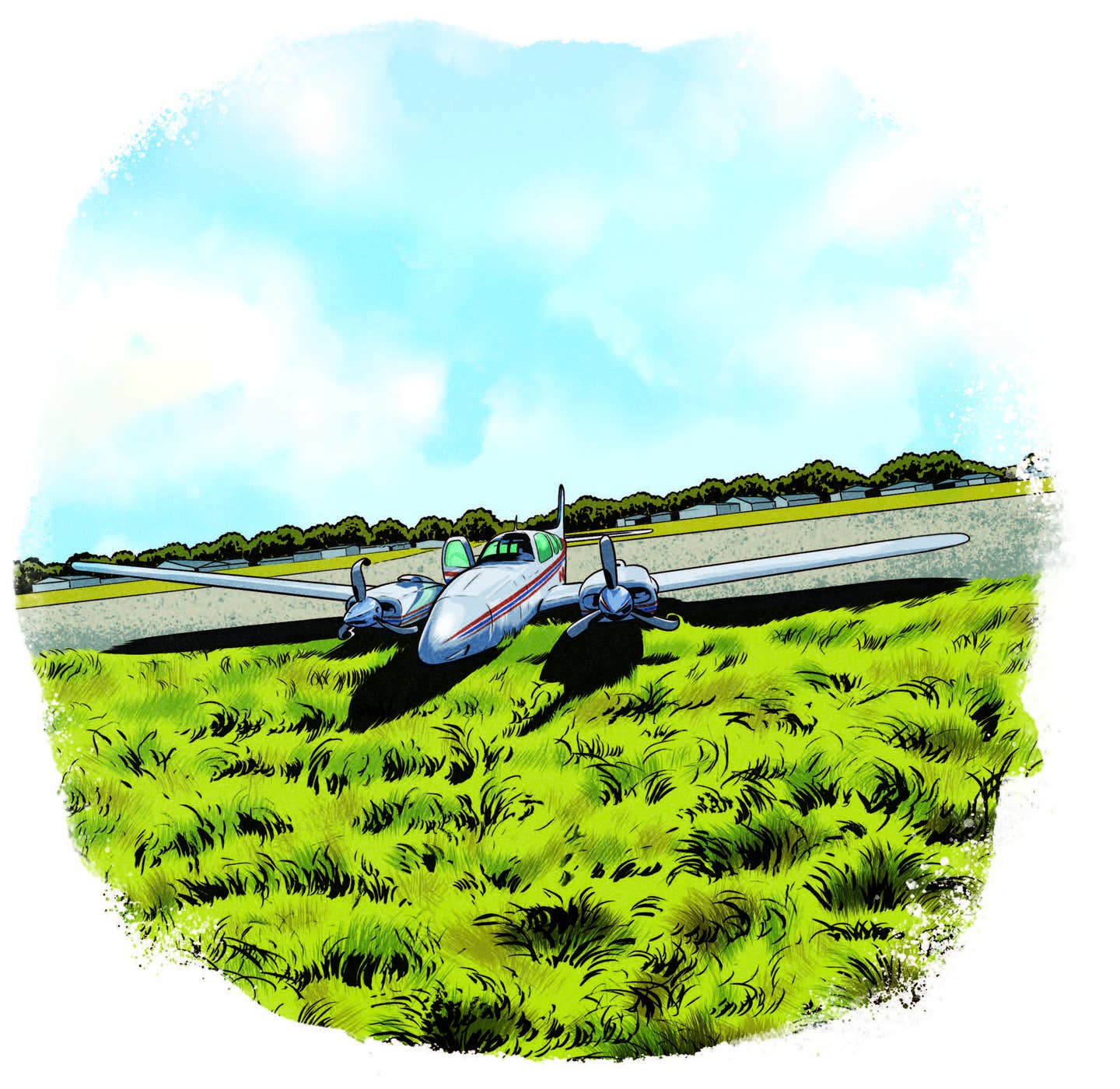
“And then it happened. Instantly, the sun turned jet black. There was a communal gasp as everyone’s jaw dropped at once. The sun was the blackest shiniest black that black can be. The corona backlit the distant horizon. It was eerie and beautiful.” Barry Ross/BarryRossArt.com
A solar eclipse seemed like the perfect excuse for a cross-country flight to Jackson Hole, Wyoming, from San Diego with friends in our recently acquired Cirrus SR22T. My close friend Howard was just as excited for the trip as I was. Our less adventurous wives, not so much. My wife protested, “I don’t get it, why all the travel? It gets completely dark right here in our backyard every single night.” Five years and 2,000 hours later and she is still anxious about flying, but with prodding she agreed to go.
It was only two months before the eclipse, but good luck on the internet landed us two acceptable, albeit exorbitantly priced, hotel rooms, the last the town had to offer. I bought a bunch of cheap eclipse glasses on Amazon, along with a few books on the subject so that by the time we departed I was an eclipse expert.
The weather looked benign, with just the usual midsummer threat of afternoon thunderstorms. My biggest flight planning challenge was sorting through the weight and balance because it was the first time I would pack this airplane to its limits. I’ve known Howard for three decades, and over the years he has expanded in both depth of personality and bodily size. My flight plan said three hours and 44 minutes, which I thought we might want to do without stopping. I realized we could comfortably make it if I filled the tanks a couple of gallons shy of a top-off, dialed back the throttle to 70 percent power and cleared all excess weight from the baggage compartment. It would increase our flight time to four hours, but eliminate the need for a stop if we all had the stamina.
Two weeks before departure, Howard’s primary care doctor suggested his age, weight and adult-onset diabetes necessitated a stress test. The test was abnormal, leading to a cardiac procedure. The procedure had a good outcome, but there was a minor glitch when his heart stopped beating and he had to be shocked to restart it while still wide awake. This sudden electrical blow to the chest feels exactly how it sounds — quite shocking — and Howard was understandably on edge ever since. I happened to be the cardiologist who shocked him and then implanted his coronary stent, and I deemed him good to go. Besides, the near-death experience had begun to motivate him, and he was now 5 pounds lighter, meaning I could add nearly one more gallon of avgas.
I’ve learned how distracting anxious passengers can be during the boarding process, so the night before departure I visited the aircraft. I did a preflight, fueled it to the perfect level, checked the oil and removed every nonessential fragment from the baggage compartment to make room for all the luggage and still keep within our weight limits. The next morning, after demanding everyone use the restroom, we boarded and lifted off. The ceiling was 800 feet overcast, so it started as an instrument flight. Since we were headed to mountainous terrain, we stayed IFR despite gorgeous weather en route. I had selected several potential stopping points, but each time we approached a rest stop, the unanimous vote was to press on.
I had planned the trip at 9,000 feet to keep the passengers comfortable, and the ride was mostly smooth, with short diversions to avoid a few pop-up summer storms. Our last potential stop was just north of Salt Lake City, but with 50 minutes to go, there were no takers. Everyone wanted to keep going.
As we approached the mountains, ATC moved us up to 10,000 feet, and then 11,000. It started to get a little bumpy. Howard and I were playing with the two oxygen saturation meters we had on our fingers, one reading 86 percent and the other 89 percent. We noticed if we took deeper breaths we could get them barely to 90 percent.
Then it happened. ATC moved us to 12,000 feet. I felt the slight lightheadedness and headache I usually note at that altitude. Howard did not like it at all. He started squirming in his seat, saying, “I don’t feel right.” He became more anxious, repeating, “I don’t like this.”
Now, his back was hurting and he kept saying, “I can’t breathe up here.” He said he needed a men’s room and reminded me of his lumbar disc problem that was now in acute spasm. Below us, the weather was perfectly clear, and we were well above the Teton mountains, so I asked ATC for lower. The controller responded, “I can’t give you lower over that terrain due to the [minimum en route altitude], but I can give you higher.” Howard exploded. “Higher? What is he crazy? He wants us to go higher? Doesn’t he know there is no oxygen up here?” Howard had a good point, and I realized while we did not legally need oxygen at 12,000 feet, the Cirrus was equipped with an oxygen tank, so why not use it? I asked Howard’s wife to reach in the back for the bag with all the oxygen flow meters and cannulas, but while she was rummaging around, it dawned on me I had removed all the necessary tubing and paraphernalia along with everything else — to make room for the luggage!
Howard’s wife was now trying to calm him down, but the situation was escalating, with complaints of headaches, dizziness, air hunger, back pain and a full bladder. Dealing with an anxious passenger was something I had read about during my flight training, but until that moment I had not appreciated the full impact of the distraction and serious danger of the situation. If things kept going the way they were, I would soon be declaring an emergency.
I canceled IFR, kept my beacon code for flight following and rapidly descended into a valley just west of our position. When I got down to 8,500 feet, Howard felt better, so I stayed low for about 10 minutes and then slowly climbed, reaching 11,500 feet but only briefly as I weaved my way through the mountain passes until entering the Jackson Hole valley for landing.
Jackson Hole is gorgeous, and that Monday was perfect for an eclipse. We realized the optimal viewing spot was right in front of our hotel, so we pulled up some lawn chairs, put on our eclipse glasses and looked at the sky.
And then it happened. Instantly, the sun turned jet black. There was a communal gasp as everyone’s jaw dropped at once. The sun was the blackest shiniest black that black can be. The corona backlit the distant horizon. It was eerie and beautiful. For exactly two minutes and twenty seconds, we stared in disbelief. And then, bam — a circle of blinding white light suddenly appeared to another simultaneous gasp from across the valley. Despite all my preparation, I had no clue it would feel that profound.
We made it back to the airport by midafternoon. For our return flight, I had learned my lesson and planned a stop a little more than halfway home. I chose Cedar City, Utah, because it was at 5,000 feet so it would be cooler in August than most other options. I made the flight VFR, stayed below 12,000 feet over the mountains and then dropped to 10,500 for cruise. Isolated storm cells began popping up around us as we approached our rest stop, but otherwise, it was clear and so smooth that we had to wake the girls for landing.
I called Flight Service and learned that our intended tour of the Grand Canyon was in jeopardy due to a nidus of storm-cell activity directly over the rim. In fact, we could see a large cell about 50 miles south closing in on the runway. We decided now would be a good time to make our break.
We loaded up, and I cranked the engine after configuring for the most reliable of my hot-start procedures. No luck. I waited 20 seconds and tried again. The engine turned over but wouldn’t start. My iPhone has a file called “Hot Starts” containing no less than seven hot-start procedures provided by friends, books and instructors. Nothing worked. As the storm got closer, I tried calming everyone down, explaining this was all normal and did not suggest a malfunctioning engine, but their protests grew louder and louder. Howard was directing the show again. He spoke slowly and evenly. “Paul, why don’t we just go inside for a couple of hours and wait for the storm to pass.” One by one, we watched other aircraft take off. I kept cranking the engine while Howard kept talking. I finally lost my cool and told Howard everything would be fine if I could just hear myself think. Finally, my “flooded start” procedure worked. We scooted to the runway, did a quick preflight and took off, keeping an eye on the approaching storm out the left window. Nexrad confirmed very significant cell activity to the east of Las Vegas. We would have to put off our planned tour of the Canyon. It had been a long day and a phenomenal weekend, and we all agreed — we had enjoyed as much of this as we could stand.
What I learned from the eclipse:
- Flying with nonpilot passengers requires additional planning. Preflight weight and balance and safety instructions are a given, but remember, your passengers are having a very different experience from yours.
- With nonpilot passengers, it's much better to embrace the adventure and not focus on the destination. If there is any consideration about stopping, take a break.
- If you are flying higher than about 10,000 feet with passengers, at a minimum bring an inexpensive, light spray oxygen canister for a quick, intermittent pick-me-up. Everyone experiences higher altitudes differently.
- Brief your passengers on things like problematic hot starts that might cause a delay well before departure so they can be mentally prepared.
- Beginner pilots can be wary of asking ATC for changes. Don't be shy about challenging ATC, including canceling IFR in some conditions.
- Book learning is wonderful, but when it comes to passenger emergencies and total eclipses, there is no substitute for being there.
- A 99 percent eclipse is interesting, but a total eclipse is a life experience. Don’t miss it in 2024.

Sign-up for newsletters & special offers!
Get the latest FLYING stories & special offers delivered directly to your inbox






